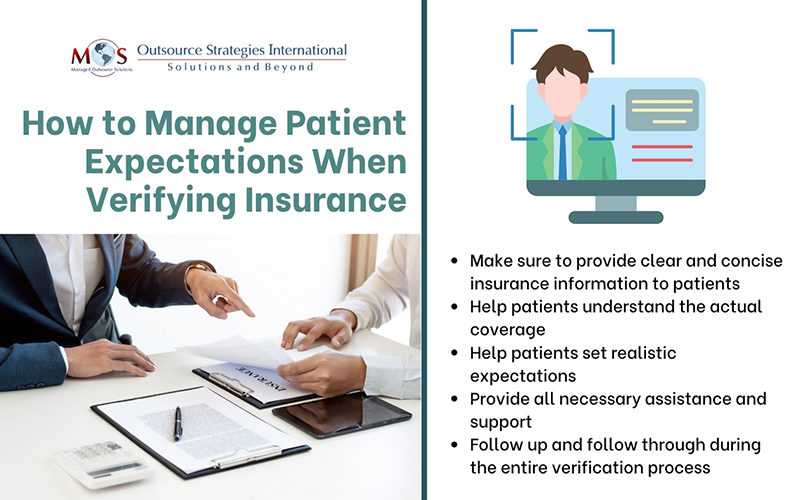Setting realistic expectations for patients in insurance eligibility checks is one of the most important things to remember. As a provider, you may be worried about annoying patients by engaging in insurance eligibility verification. Don’t be. You can always do this in a way that provides a better patient experience without overstepping boundaries or being a nuisance.
Successfully managing patient expectations is crucial for ensuring a positive patient experience and minimizing misunderstandings throughout the process of verification of patient benefits.


Provide the patient-centric care that modern healthcare demands while we handle your insurance eligibility verification needs.
Strategies for Addressing Patient Concerns during Insurance Verification
- Ensure that you communicate clearly to the patient: Provide clear and concise information to patients about what they can expect during the insurance verification process. Explain the steps involved, such as providing insurance information, verification timelines, and potential outcomes. Your front desk staff can inform the patients during scheduling or registration about the importance of providing accurate insurance coverage information. The patient should also be informed that the verification may take up to 24 – 48 hours. Staff should also explain the potential scenarios the patient could encounter based on their insurance coverage.
- Educate patients about the coverage available: Help patients understand their insurance coverage, including deductibles, co-pays, and any limitations or exclusions. This helps manage expectations regarding out-of-pocket costs and coverage for specific services. You can provide this education in the form of educational materials and FAQs about insurance coverage, deductible explanations, and tips for navigating the insurance verification process. Patients can access this information before their appointment to better understand their financial responsibilities.
- Ensure transparency: Be clear about the potential outcomes, including scenarios where coverage may be denied or require pre-authorization. Inform patients about their options for addressing coverage issues. If a patient’s insurance coverage requires pre-authorization for a specific procedure, your billing department can proactively contact the patient to explain the situation, discuss alternative options, and assist in obtaining pre-authorization.
- Set realistic expectations: Manage patient expectations by being realistic about timeframes and limitations. Avoid promising or guaranteeing outcomes that are dependent on insurance policies. For example, during the scheduling process, your staff can inform patients that while they strive to verify insurance coverage as quickly as possible, certain factors like holidays or weekends may affect processing times. Patients can be advised to plan accordingly and provided with contact information for follow-up inquiries.
- Provide all necessary assistance and support : Be proactive in assisting patients. Provide resources, guidance, and support to address any concerns or questions that arise. Take the case of a patient who receives a notification from his insurance company denying coverage for a planned procedure. Your patient advocate can reach out to the patient to explain the denial reason, explore appeal options, and assist in gathering the necessary documentation to challenge the decision.
- Follow-up and follow through: Maintain communication with patients throughout the process and follow through on commitments made regarding assistance, updates, or resolution of coverage issues. Once initiated, your billing department can follow up with the patients and provide updates on the status of their coverage. If there are any delays or issues, they can proactively communicate with patients to keep them informed and address concerns promptly.

Want to explore further?
Navigate through the realm of patient communication and insurance verification to gain valuable insights
By implementing the best practices listed above for managing patient expectations in healthcare insurance checks, healthcare providers can effectively manage patient expectations, and ensure enhanced patient satisfaction, reduced billing disputes, and smoother administrative workflows. By educating patients about their insurance eligibility, you empower them to take charge of their own health. At the same time, you are also giving them a good understanding of their responsibility, which will enable them to act accordingly.


Outsource Strategies International (OSI) is your trusted provider of insurance verification services.
CALL (800) 670-2809 Today





